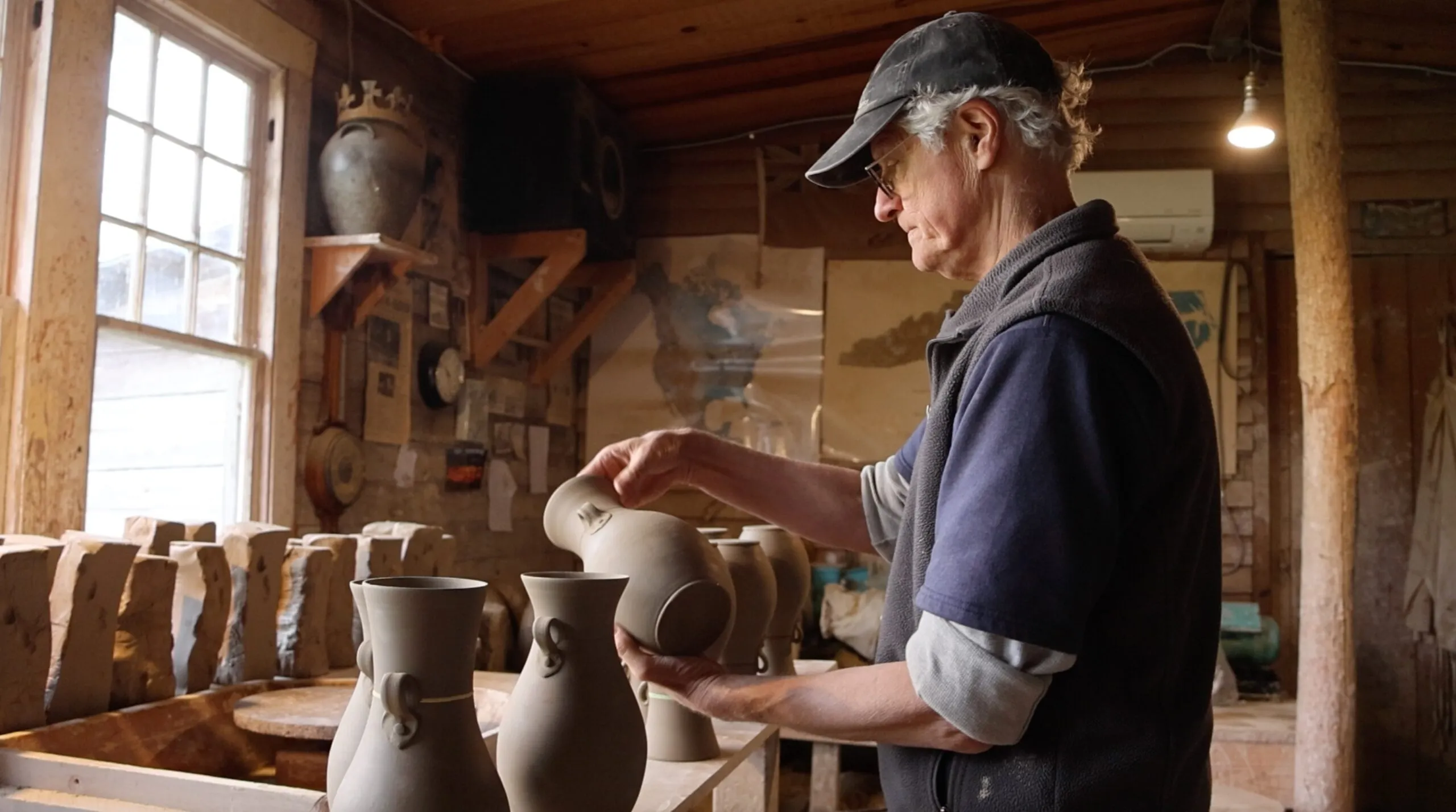
Inside his dimly lit pottery studio on a secluded backroad in Pittsboro, North Carolina, Mark Hewitt sits on a stool holding a mug filled with coffee in his clay-stained, calloused hands.
On the surface, there’s nothing extraordinary about the mug. It’s brown, with a semi-circle handle.
But the mug’s finest details tell the story of a young Brit who crossed the Atlantic nearly half a century ago, inspired to work with his hands – and a pottery wheel – to create pots, vases and other unique works of art.
“It’s like a tangible poem,” Hewitt said. “It’s got all sorts of references, that to an outsider that you wouldn’t get. But having studied pottery and all of its many facets over the years, I’m able to embody all of that in a moment of creativity when I’m at the wheel, when I’m decorating it, when I’m putting the handle on it and when I’m glazing it.”
That sturdy brown mug contains the story of Hewitt’s path to where he is today: one of the most renowned potters in a state that’s known for its pottery.
“He is arguably one of the state’s best-known potters,” said Lindsey Lambert, the executive director at the North Carolina Pottery Center. “Some of his stuff that he’s producing is stuff that 200, 250 years from now will still be significant to North Carolina’s pottery history.”

Mark Hewitt looks over a pot in his workshop. | Photo courtesy of Joshua Dolgoff
‘That was an epiphany’
Mark Hewitt didn’t want to be just like his family. He wanted to be different.
He wanted to be rebellious.
Hewitt was born in Stoke-on-Trent, a city in England that is the center of the British pottery industry. His dad and granddad were both directors at the Spode company, a company that makes industrial pottery in its factories.
As a rebellious college student, he wanted nothing to do with industrial pottery, and that’s when he learned about the tradition of hand-made pots. Hewitt found a book by an English potter named Bernard Leach titled “A Potter’s Book.” It was about pots that were made by hand using traditions from China, Europe and Japan. Not far from the University of Bristol where Hewitt was studying, there was a collection of these pots at the Bristol Museum and Art Gallery. After going to the museum to see the pots, he was hooked.
“Despite having been raised in a household where there were pots everywhere, I had never seen pots as beautiful as those in the museum,” Hewitt said. “That was an epiphany.”
So he wondered how he could expand this newfound love of his. How could he sustain a career out of making hand-making pots?
The answer was simple – an apprenticeship.
And who better than Leach’s first-ever apprentice – Michael Cardew – to teach him? A well-experienced potter, Cardew was 76 years old when Hewitt apprenticed for him, providing Hewitt a good look at what he was getting himself into if he wanted to be a potter. For three years he apprenticed for Cardew, and for three years he was given a trial by fire, both literally and figuratively.
“He was a difficult man,” Hewitt said. “He was sort of an old curmudgeon. He was given to belittling his apprentices if they made mistakes, which was not fun.”
While he came out of the fire polished, he wasn’t quite yet ready to go into the pottery industry on his own. So off he went across the Atlantic to Connecticut for a second apprenticeship, this time under a fellow former Cardew apprentice, Todd Piker.
From 1979 to 1983, Hewitt studied under Piker, continuing to learn more about making pots and how exactly to make them for a living. He finished his second apprenticeship in early 1983 and was ready to begin making pottery on his own.
While his hands alone would make the pottery, he couldn’t build his studio by himself. While Hewitt gained experience in Connecticut, he also found love, meeting his eventual wife, Carol.
‘Why do I have to keep doing this?’
Surrounding Mark Hewitt are various topographical maps of North Carolina and the United States, like the ones in your high school history class.
Where Hewitt would build his future studio would be vitally important. If the land where he built it didn’t have good clay, his business would flounder. As a result, he set his sights to the South where the clay was both good and plentiful.
Initially, he wanted to live on the Mississippi River in either western Kentucky or Tennessee, because the clay was very good quality. However, there weren’t any towns of size, meaning his pottery wouldn’t supported financially.
In order to decide where best to live, Hewitt relied on the current potters in the South, visiting Georgia, North Carolina and South Carolina with Carol to scope out the scene. On their second trip through, they stopped in Carrboro, North Carolina and stayed with one of his wife’s cousins. During this he got advice that would shape the next 41 years of his life.
“We were staying with Cousin Beth, and she said, ‘Well, why don’t you call a particular realtor in Siler City and see if she’s got any inexpensive properties,’ because friends of hers had used this particular realtor,” Hewitt said. “So we called.”
But the Hewitts couldn’t just live anywhere. Carol had two requirements. First, there had to be a theater within 30 minutes where she could watch foreign films and second, it had to be close to a natural food store.
The real estate agent came back and suggested Pittsboro, offering two potential properties, a garage on the highway and an old, dilapidated farm at the end of a dirt road.
“I said, ‘Let’s go take a look at [the farm],’ because a few of my potter friends from England had bought old farms,” Hewitt said. “This was the first and only place we looked at.”
When they went to the farm, it was in disarray with many of the buildings in need of repairs. So why’d they buy it?
For one, the price was right. In addition to the property being in disarray, the owner was in dire need of money and was “selling it for a song,” according to Hewitt. Also, when they were viewing the property, a heron flew across Mark’s eyeline. He took it as a sign from Cardew, who often painted herons on his pots, to buy the property.
After building a kiln and fixing up the farm, including renovating an old chicken house into his studio, cutting out the floor and adding a clay floor in its place, Hewitt was ready to begin his solo pottery journey.
He quickly discovered that the decision to move to North Carolina was the right one.
“I came to a state where the people were already primed in terms of their love of pottery, and I hadn’t realized,” Hewitt said. “I remember going to my first craft show over at the fairgrounds at N.C. State, and there were people coming up saying, ‘I just love pottery.’ I hear that so often. You don’t hear that in Oklahoma or Massachusetts.”
Through the early successes and making a name for himself in the North Carolina pottery scene, so came the errors and self-doubts.
In his early years, Hewitt had firings in which he made silly errors, like using subpar clay or being careless in his crafting, that resulted in the clay falling apart. Still having a bit of that rebellious spirit, his mind was going faster and thinking ahead of where his hands were.
“You make stupid mistakes,” Hewitt said. “It’s unbelievably easy to ruin a pot. You do stupid things, and you think, ‘Why on Earth am I doing that? Why do I have to keep doing this?’”
Yet, Hewitt was all-in on this; he didn’t have a plan B.
Hewitt had forgone what he studied at the University of Bristol to pursue pottery. He had taken two apprenticeships over seven years. He had bought the shoddy farm and fixed it up. He had spent too much time and effort to back out now.
“Particularly in your early years, you don’t like what you’re doing because you’re still young at it,” Hewitt said. “My pots are now like 45-year pots. They’re not 3-year-old pots. It’s like an accumulation.”
Year after year, Hewitt improved at making pots. The mistakes became less and less frequent, and his style started to become distinctive from that of Cardew and Piker, finding what he liked and sticking by it.
By the mid-2000s, he had ascended to become one of the top potters in North Carolina. In addition, he’d had numerous solo exhibitions and co-published a book titled, “The Potter’s Eye: Art and Tradition in North Carolina Pottery.”
“Mark was a pivotal character in the story of North Carolina pottery in the 1990s and 2000s,” said Matt Jones, Hewitt’s apprentice in the fall of 1999.
By that time, Hewitt had taken on numerous apprentices, like Jones, teaching them just as he had been taught.
‘That’s quintessential Mark’
As Joseph Sand sat in the passenger seat of Mark Hewitt’s car, the two were engaged in a conversation just as they usually were when Sand apprenticed under Hewitt from 2006 to 2009. Eventually, the pair got to a red light and were still locked on what the other was saying.
Hewitt paid no mind to the traffic light and was focused solely on the conversation at hand as if it were a piece of pottery that needed to be shaped.
While he was talking, Sand was thinking to himself, “What the hell is going on?” Not because of what Hewitt had said but because his mentor had failed to realize that the light had already turned green and was now yellow, only seconds away from turning red again.
Hewitt turned his head to the road ahead and said, “Oh, shit.”
He hit the gas just in time to make the light, leaving the line of cars behind to suffer through another cycle of sitting at the light.
“That’s just characteristic of Mark, him being so engaged when you’re telling a story or talking about a conversation,” Sand said. “That’s quintessential Mark, which I love.”
Starting in 1994 when he took his first apprentice, Hewitt has had 27 apprentices work for him in Pittsboro, spreading North Carolina’s pottery tradition and sharing his love of pottery with other people.
Due to Hewitt’s explementary work, he’s made quite an impression on the pottery landscape in the state.
“A major contribution that he’s making is that he has had a number of apprentices over the years himself,” Lambert said. “He’s taking that blend of his own experiences and work and sharing that with that younger generation.”
The generation of potters that have come through Hewitt’s studio has learned from him and had similar experiences to those of Hewitt.
Many of the apprentices Hewitt takes on are individuals who are fresh out of college, just as he was when he apprenticed under Cardew. Then there are individuals like Stillman Browning-Howe, Hewitt’s apprentice from 2016 to 2020, who know they want to be a potter before they even finish high school. Still, the experiences of a young potter remain the same.
Just as Hewitt needed to make mistakes to learn, even if it made him want to quit, he’s impressing the same lessons upon his apprentices.
“You have the freedom to really push yourself and be willing to watch the clay collapse underneath you because you pushed a little too far and then just try again and try again,” Browning-Howe said.
At the same time, Hewitt is also giving his apprentices someone to look to for advice once they are on their own.
Just as Bernard Leach’s book was the reason Hewitt wanted to get into pottery, Hewitt was the reason why Sand decided to get into the pottery business and stay in the pottery business, rather than go back to school and earn a graduate degree.
“He really is a dear friend,” Sand said. “I wouldn’t be doing this if it wasn’t for him, so I owe him a lot.”
The impact Hewitt has had on his apprentices is notable from how they speak of him and from their works. Similar to how Hewitt imitated Cardew and Piker when he first made pottery for himself, when you look at the work of Hewitt’s apprentices, you can see a hint of Hewitt’s style hidden within the details.
When you look at the pottery industry, and the works across the country, you’ll not only see Hewitt in his pieces, but you’ll also see him in the work of his apprentices who are starting to make a name for themselves.
“A couple hundred years from now, people will be able to look at the family tree of Mark’s apprentices and see the impact they’ve had not only in North Carolina but other places as well,” Lambert said.
‘Maybe I should quit while I’m ahead’
Sitting at his wheel late in the afternoon, Hewitt is feeling the weight of having thrown pottery all day.
He isn’t the youthful potter he was when he first started. He’s now 68, just eight years younger than Cardew was he apprenticed under him. Hewitt’s still holds onto the lessons his mentor impressed upon him, the ones he gained when the “old curmudgeon” wasn’t being difficult.
“The thing I learned [from him] was that you could still be enthusiastic about pots at an old age,” Hewitt said. “He was 76 when I first got to work with him. I’m 68 now. I’m still as passionate about making pots and all the aspects of pottery culture as I was when I first started, if not more so.”
Hewitt’s love of pottery is the reason why he still does this. The reason why he wakes up early in the morning to throw clay on the wheel. The reason why when you ask him about the clay of North Carolina, he tells you all about the centuries-old pottery tradition in the state.
He knows there’s going to be a physical decline inevitably, and sometimes he thinks he should quit while he’s ahead, but he hasn’t yet, and he might never do so.
“It’s been a good run as a married man and as a potter [in North Carolina],” Hewitt said. “Sometimes at three o’clock in the afternoon when I’ve been making pots all day and I’m tired, and I get tired a little bit more easily now that I’m older, that’s hard. But you know, I don’t seem to know how to quit.”
His refusal to quit is symbolized in his calloused, clay-stained hands.
In that simple mug he drinks his coffee out of.
In the mug that tells a story – the story of his journey to an old farm on a dirt road in Pittsboro.
The story of Mark Hewitt.
 Stories from the UNC Media Hub are written by senior students from various concentrations in the Hussman School of Journalism and Media working together to find, produce and market unique stories — all designed to capture multiple angles and perspectives from across North Carolina.
Stories from the UNC Media Hub are written by senior students from various concentrations in the Hussman School of Journalism and Media working together to find, produce and market unique stories — all designed to capture multiple angles and perspectives from across North Carolina.

